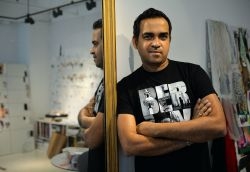Designer Bibhu Mohapatra’s journey from India to New York

“It reminds me of my childhood in India where you’d put up mosquito nets at night, but with a little glitter in it,” the 41-year-old designer said.
“It’s sheer, but it drapes beautifully, so I’m trying to figure out how to utilize it.”
Such scenes of creative experimentation are unfolding in fashion houses big and small in the run-up to the Spring 2014 collections that start coming down the runway in New York on Thursday.
More than 300 shows and presentations are on the schedule at Lincoln Center and other venues, before the fashion spotlight swings over to London, Milan and Paris.
Mohapatra will send out his latest creations for the namesake label on September 11, but if he’s feeling the pressure, he doesn’t show it.
In a black T-shirt, jeans and sneakers, he’s a serene presence in the 11th floor studio/showroom/atelier where he employs seven people full time, up from two when he started out nearly five years ago.
“It’s been really quite an interesting journey,” he told AFP one recent morning. “As long as you’re open to learning, then you can really build something.”
Mohapatra’s interest in fashion goes back to his childhood in the Indian state of Orissa where, on an old sewing machine and some tutoring from his mother, he created outfits for his first muse — his sister.
What he calls “a detour in my life” led him in 1996 to university in the western US state of Utah, where he picked up a graduate degree in economics.
Moving to New York, he enrolled in the Fashion Institute of Technology, won its Critic’s Award for Best Evening Wear Designer in his senior year, interned at Halston, then spent eight years as design director at J. Mendel.
Since striking out on his own, his list of clients and fans has grown to include Hollywood stars and First Lady Michelle Obama, who selected a yellow print dress from his 2012 resort collection for a talkshow appearance.
For this season, Mohapatra is taking inspiration from Wendy Whelan, a close friend who is reinventing herself through modern dance at the age of 41 after retiring as principal dancer with the New York City Ballet.
“She’s like a little kid trying to explore a new world,” he said. “She’s an artist and she’s found a new language with which to express herself.”
That’s something he can relate to, as his business shifts into a higher gear and his profile grows in Asia thanks to an exclusive agreement with Hong Kong-based luxury retailer Lane Crawford.
“I’m at a stage where I want to experiment with fabrics and materials and mix everything,” he said. “My field of research is kind of boundary-less and I draw inspiration from everything and everywhere.”
Turning inspiration into reality typically involves a lot of drawing.
“I go through weeks of sketching, getting an idea on a piece of paper,” he said. “It takes a long time — sometimes a week, sometimes a couple of weeks — before I really deliver something that is relevant to me.”
If designer’s block ever strikes, Mohapatra flees the frenzy that is New York for the solitude of “my tiny little house” in rural Columbia County, a couple of hours by train up the Hudson River.
It was near there, inside a 19th century manor turned women’s prison, that he filmed a haunted-house video showcasing his fall 2013 collection inspired by surrealist Man Ray and 1920s Paris.
“I’m a homebody,” said the designer who shuns the hard-partying side of the fashion world. “Every time my evening plans fall through, I’m like, ‘Woo-hoo, going home, watching TV, ordering in food.'”
Twice a year, Mohapatra returns to India, where he is participating in a government-backed effort to revive the manufacture of traditional handloom textiles in Orissa.
“I do miss India,” he confided. “I miss the people. I miss the food… It’s very inspiring, going to villages and seeing a whole other world of artistry that has been alive for generations. It just really makes you humble.”
Going forward, Mohapatra says the label that bears his name “definitely has to be bigger.” Key to that vision is building a retail presence within three years in New York and beyond.
“There are so many pockets in the world that we are trying to get into, one by one,” he said.
“We are pretty well recognized in the Middle East and now we’re starting to be in Asia with the best partner you can ask for. It’s baby steps.”
Meanwhile, Mohapatra’s forged a sharper idea of the woman he designs for — well-educated, well-travelled, firmly on trend, but also a bit more demanding in the wake of the global economic downturn.
“She is no longer just dropping money and walking away with something she fell in love with,” he said.
“She takes five minutes to look at the piece and see how it’s made and asking questions she probably wasn’t asking before 2007.
“I’m an artist, but I don’t make art that just hangs on a wall,” the designer added.
“I develop a product that I hope somebody is going to be moved by in such a way that they are going to put it on their back and feel good about it — so the product has to be really right and evolve, season after season.”
On the web: www.bibhu.com

